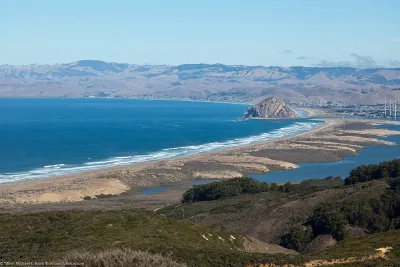Environmentalists decry the proposed wind farm as harmful to the fragile ecosystem of the Central California coast.

"A plan by private corporations to float up to eight wind power generators less than three miles offshore has run headlong into efforts to designate a vast area of ocean off the Central Coast as a Chumash Heritage National Marine Sanctuary," reports Louis Sahagún. The proposed sanctuary "would extend offshore more than 70 miles in some areas, and include shipwrecks, kelp forests, underwater canyons and a seamount that rises more than a mile above the ocean floor."
"However, applications have been submitted by Cierco Corp. and Ideol USA to the State Lands Commission for leases to install up to eight floating wind turbines in state waters about 2 ½ miles offshore, and within the boundaries of the Chumash marine sanctuary." An additional federal plan would add 380 turbines northwest of Morro Bay. "The plan would also create 44,000 jobs and help speed up our conversion from fossil fuels to renewables."
But the Northern Chumash and conservationists oppose the plan, citing potential damage to the delicate, "uniquely Californian" local ecosystem. "Building a network of floating turbines that are tethered to the seafloor and connected to one another and the mainland with electric cables is an affront to preservation, [members of the Northern Chumash Tribe] say."
The Chumash aren't alone in their opposition to the project. "Critics of the wind turbine proposal include tribal leaders, the California Coastal Commission, NOAA, the Pacific Coast Federation of Fishermen’s Assns., the Alliance of Communities for Sustainable Fisheries and a coalition of environmental groups led by Defenders of Wildlife, the Monterey Bay Aquarium, the Surfrider Foundation, Sierra Club California, the Natural Resources Defense Council, the Center for Biological Diversity and the Environmental Defense Center."
FULL STORY: A Chumash tribe and conservationists fight offshore wind turbines

National Parks Layoffs Will Cause Communities to Lose Billions
Thousands of essential park workers were laid off this week, just before the busy spring break season.

Retro-silient?: America’s First “Eco-burb,” The Woodlands Turns 50
A master-planned community north of Houston offers lessons on green infrastructure and resilient design, but falls short of its founder’s lofty affordability and walkability goals.

Delivering for America Plan Will Downgrade Mail Service in at Least 49.5 Percent of Zip Codes
Republican and Democrat lawmakers criticize the plan for its disproportionate negative impact on rural communities.

Test News Post 1
This is a summary

Test News Headline 46
Test for the image on the front page.

Balancing Bombs and Butterflies: How the National Guard Protects a Rare Species
The National Guard at Fort Indiantown Gap uses GIS technology and land management strategies to balance military training with conservation efforts, ensuring the survival of the rare eastern regal fritillary butterfly.
Urban Design for Planners 1: Software Tools
This six-course series explores essential urban design concepts using open source software and equips planners with the tools they need to participate fully in the urban design process.
Planning for Universal Design
Learn the tools for implementing Universal Design in planning regulations.
EMC Planning Group, Inc.
Planetizen
Planetizen
Mpact (formerly Rail~Volution)
Great Falls Development Authority, Inc.
HUDs Office of Policy Development and Research
NYU Wagner Graduate School of Public Service




























